
The Hall Art Foundation is pleased to announce an exhibition by acclaimed German artist Georg Baselitz opening 7 April 2023 at Kunstmuseum Schloss Derneburg and presented in the year of the artist’s eighty-fifth birthday. This is the first in a series of Baselitz exhibitions drawn from the Hall Collection that will be shown at Schloss Derneburg, which was Baselitz’s home and studio for some 32 years until its sale to Andy and Christine Hall, founders of the Hall Art Foundation, in 2006.
Baselitz in the Studio comprises some two dozen paintings and a sculpture completed in the 5 or 6 years prior to the sale of Schloss Derneburg and are some of the last works the artist made there. They will be exhibited where they were created, in the so called “Neues Atelier” (“New Studio”), a building designed by Steib+Steib Architects of Basel, which Baselitz commissioned in the mid-1990s and is situated in the park adjacent to the historic castle building. While Baselitz had studios and workshops in different parts of the castle, the new studio would become his principal studio for painting and sculpture for the next decade and has now been repurposed as an exhibition space for Kunstmuseum Schloss Derneburg. The Hall and Hall Art Foundation collections include over 400 paintings, sculptures, works on paper, and prints by Baselitz that span his sixty-year career.
Baselitz emerged as a pioneer of an expressive style of painting in Germany in the early 1960s. Seven years old when the Second World War ended, he was raised in the countryside of Saxony, and his painterly concerns were influenced by his experience of growing up in postwar Germany. He sought to confront the question of what it meant to be German and a German artist in a postwar world.
Georg Baselitz is possibly best known for his paintings of inverted figures, animals, landscapes and still-lives that emerged in 1969. Engaging these classic figurative motifs, Baselitz created upside down works in order to re-focus the viewer on the abstract qualities of his compositions rather than their representational aspects. Drawing inspiration from a broad range of influences, his novel mix of representation and abstraction allowed him to conflate the competing aesthetics of East and West Germany prevalent at the time. Of his inverted subjects, Baselitz has said: “I must take everything which has been an object of painting – landscape, the portrait and the nude, for example – and paint it upside-down. That is the way to liberate representation from content.”
The Saxonian landscape of his childhood has been employed by Baselitz as a motif and has held a central position in his work since. In Über das Wasser (2004), Baselitz uses gestural and spontaneous flashes of bright, transparent color to depict the inverted bottom half of a figure standing at the entry to a wooded path. The legs float upside down against the backdrop of a pond and pale woodland. The image of a fragment of leg, especially of a foot (sometimes in a shoe), has been an important element in Baselitz’s paintings since the 1960s, and can often be interpreted as a self-reference. Lagerplatz (Campground) (1998-2005) depicts a pair of inverted and disjointed legs floating within an abstract field of color and in the sculpture, Pace Piece (2003), Baselitz further employs imagery of the leg and foot. Several of Baselitz’s “feet” paintings and sculptures were developed in direct response to a photograph of the artist Edvard Munch, in which the elderly artist is seen sitting on a chair in his studio. In this photo, Munch’s body is cut off below the knees, and it is this imagined portion of Munch’s body that Baselitz began to incorporate in his own compositions.
A group of large-scale tondos depict the artist and his wife, Elke, his most enduring subject whom he has painted numerous times throughout his career. In works like Maria und Franz Marc (2002), the figures are not positioned naturalistically in space, but float within a field of color and pattern that is as much foreground as it is background. The gestural passages of bright, transparent color, somewhat akin to watercolor painting, are typical of Baselitz’s work at the time.
In Prierelied (2002) Baselitz explores the theme of the lone horseman. In paintings from this “cowboy series”, Baselitz references the work of late 19th century figures like Richard Wagner and the romantic Wild West author Karl Friedrich May, both of whom, like Baselitz, came from Saxony. In their works, May and Wagner each explored individual psychological struggle, and themes of good vs. evil. Baselitz reflected their conflicted notions of human identity in his cowboy paintings, relating them to the ongoing challenge of political reconciliation in a unified 21st century Germany. The reflected image of the horse and the man is made particularly striking by the background that is almost flattened or, in the words of the artist, “mirrored away” by the use of silver-colored paint.
One of the most important German artists of the post-war period, Hans-Georg Kern was born in 1938 in the Saxon village of Deutschbaselitz. In 1961 he adopted the name Georg Baselitz in homage to his birthplace. Baselitz has exhibited his work internationally for decades and has participated in numerous important group exhibitions around the world including A New Spirit in Painting, curated by Norman Rosenthal for the Royal Academy of Art in London (1981), Zeitgeist at the Martin-Gropius-Bau, Berlin (1982), and multiple presentations at documenta (1972, 1982) and at the Venice Biennale (1980, 1993, 2003, 2007, 2015). Since his 1963 solo debut at Galerie Werner & Katz in Berlin, major solo presentations include a retrospective organized by the Guggenheim Museum, New York, that traveled to the Los Angeles County Museum of Art, the Hirshhorn Museum and Sculpture Garden, Washington D.C., the Nationalgalerie Berlin (1995-96) followed by a major show at Musée d'Art Moderne de la Ville de Paris (1996). Baselitz’s Remix cycle was first presented at the Pinakothek der Moderne, Munich (2006), and the Albertina, Vienna (2007), the same year as his retrospective at the Royal Academy of Arts, London (2007). A comprehensive survey of Baselitz’s sculptures was held at the Musée d'Art Moderne de la Ville de Paris (2011 – 2012), followed by solo exhibitions at the Albertina, Vienna (2013), and Haus der Kunst, Munich (2014). Baselitz’s Heldenbilder (Hero Paintings) and Neue Typen (New Types) were shown at the Städel Museum, Frankfurt (2016), travelling to the Moderna Museet, Stockholm; Palazzo delle Esposizioni, Rome; and Guggenheim Bilbao. In 2018, comprehensive solo exhibitions were held at the Fondation Beyeler, Basel; Hirshhorn Museum, Washington, D.C.; and Musée Unterlinden, Colmar, France. Most recently, important solo exhibitions of his work have been presented at Gallerie dell'Accademia, Venice, Italy (2019), Centre Pompidou, Paris, France (2021-22), Museo di Palazzo Grimani, Venice, Italy (2021-22) and The Morgan Library & Museum, New York, NY (2022). In 2023, exhibitions of Baselitz’s work can be seen at the Pinakothek der Moderne, Munich, Germany, the Albertina Museum, Vienna, Austria and Kunsthistorisches Museum Wien, Vienna, Austria. Baselitz currently lives and works between three different locations: Lake Ammersee in Bavaria, Salzburg, Austria and Imperia in Liguria, Italy. His works can be found in institutional collections around the world.
For more information and images, please contact the Hall Art Foundation’s administrative office at info@hallartfoundation.org.
The exhibition is only accessible by guided tour.
PUBLICATION
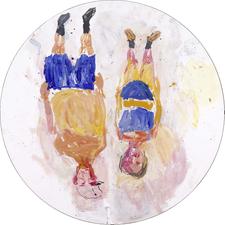
Georg Baselitz
Maria und Franz Marc, 2002
Oil and pencil on canvas
Diameter: 114 in. (290 cm)
Hall Collection. Courtesy Hall Art Foundation
© Georg Baselitz 2023
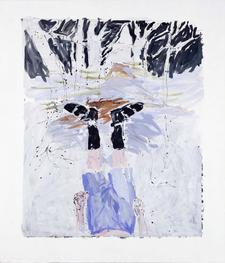
Georg Baselitz
Über das Wasser, 2004
Oil on canvas
116 x 98 in. (294 x 250 cm)
Hall Collection. Courtesy Hall Art Foundation
© Georg Baselitz 2023
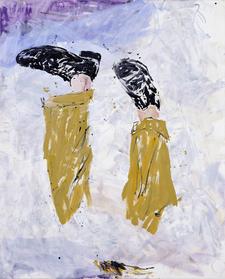
Georg Baselitz
Lagerplatz (Campground), 1998-2005
Oil and lacquer on canvas
81 x 65 in. (206 x 166 cm)
Hall Collection. Courtesy Hall Art Foundation
© Georg Baselitz 2023
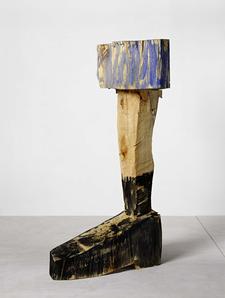
Georg Baselitz
Pace Piece, 2003
Oil on lime wood
64 x 21 x 34-1/2 in. (162 x 53 x 88 cm)
Hall Collection. Courtesy Hall Art Foundation
© Georg Baselitz 2023
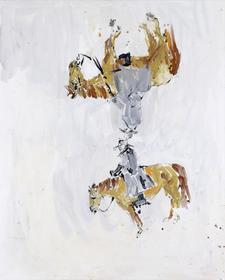
Georg Baselitz
Prierielied, 2002
Oil on canvas
64 x 51 in. (162 x 130 cm)
Hall Collection. Courtesy Hall Art Foundation
© Georg Baselitz 2023
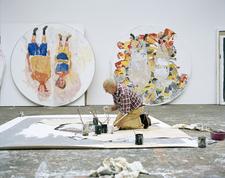
Georg Baselitz working in the "New Studio" at Schloss Derneburg, 2004
Photo: Martin Müller, Berlin
Courtesy Hall Art Foundation
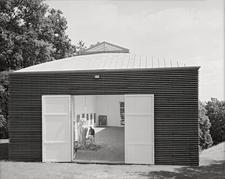
Georg Baselitz working in the "New Studio" at Schloss Derneburg, 1995
Photo: Martin Müller, Berlin
Courtesy Hall Art Foundation